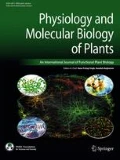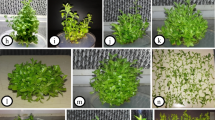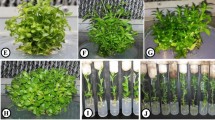Abstract
An efficient plant regeneration protocol using axillary shoots of the salt accumulator halophyte, Sesuvium portulacastrum (L.) L. was established and in vitro responses of six Sesuvium clones were studied. The shoot and root induction responses to cytokinins and auxins in clone MH (Maharashtra) were concentration specific. Significantly the highest number of shoots, average shoot elongation and percent shoot regeneration per explant were observed on MS medium supplemented with 40 μM 2-isopentenyl adenine (2iP) followed by 20 μM benzyladenine (BA). Higher cytokinin (60 μM), however, inhibited shoot induction and shoot length. The lower concentrations (5 or 10 μM) of α-napthaleneacetic acid (NAA) proved more effective for root induction, number of roots and average root length. Well-developed plantlets were successfully hardened and established in the field with more than 85 % survival rate. In vitro response of six Sesuvium clones cultured on MS + 20 μM BA revealed higher multiplication rate in clone MH and KA (Karnataka, India) compared to other clones. The results offer the prospect of selecting clones of this species with characteristics desirable for utilization and/or restoration in specific ecological zones.
Similar content being viewed by others
References
Abdulaziz MAB and Jammel MAK (2003). Micropropagation of grey mangrove Avicennia marina. Plant Cell Tiss. Org. Cult. 72: 87–93.
Amor NB, Hamid KB, Debez A, Grignon C and Abdelly C (2005). Physiological and antioxidant responses of the perennial halophyte Crithmum maritimum to salinity. Plant Sci. 168: 889–899.
Balasubramanian R, Thilo R, Ahmed D, Ralf S, Bernhard H, Ahlert S and Jutta P (2006). Aster tripolium L. and Sesuvium portulacstrum L.: two halophytes, two strategies to survive in saline habitats. Plant Physiol. Biochem. 44: 395–408.
Barrueto CLP, Machado ACMG, Carvalheira SBRC and Brasileiro ACM (1999). Plant regeneration from seedling explants of Eucalyptus grandis x E. Urophylla. Plant Cell Tiss. Org. Cult. 56: 17–22.
Bhau BS and Wakhlu AK (2001). Effect of genotype, explant type and growth regulators on organogenesis in Morus alba. Plant Cell Tiss. Org. Cult. 66: 25–29.
Cherian S and Reddy MP (2003). Evaluation of NaCl tolerance in the callus cultures of Suaeda nudiflora Moq. Biol. Plant. 46: 193–198.
Giridhar P, Gururaj HB and Ravishankar GA (2005). In vitro shoot multiplication through shoot tip cultures of Decalepis hamiltonii Wight and Arn., A threatened plant endemic to Southern India. In Vitro Cell. Dev. Biol. Plant 41: 77–80.
Grigoriadou K and Maloupa E (2008). Micropropagation and salt tolerance of in vitro grown Crithmum maritimum L. Plant Cell Tiss. Org. Cult. 94: 209–217.
Jayanand B, Sydarsanam G and Sharma K (2003). An efficient protocol for the regeneration of whole plants of chickpea (Cicer arietinum L.) by using axillary meristem explants derived from in vitro-germinated seedlings. In Vitro Cell. Dev. Biol. Plant 39: 171–179.
Joshi P and Dhawan V (2007). Axillary shoot multiplication of Swertia chirayita (Roxb. Ex Fleming) H. Karst., a critically endangered medicinal herb of temperate Himalayas. In Vitro Cell. Dev. Biol. Plant 43:631–638.
Kathiresan K, Ravishankar GA and Venkataraman LV (1997). In vitro multiplication of a coastal plant Sesuvium portulacastrum L. by axillary buds. In: Biotechnological applications of Plant Tissue and Cell Culture (Eds. Ravishankar GA and Venkataraman LV), Oxford and IBH Publishing C., Pvt. Ltd., India, pp. 185–192.
Keul AB, Suteu A and Deliu C (2005). In vitro organogenesis of Gentiana punctata. Not. Bot. Hort. Agrobot. XXXIII, ISSN 0255-965X, pp. 38–41.
Kumar R, Sharma K and Agarwal V (2005). In vitro clonal propagation of Holarrhena antidysentrica (L.) Wall. through nodal explants from mature trees. In Vitro Cell. Dev. Biol. Plant 41: 137–144.
Landi L and Mezzetti B (2006). TDZ, auxin and genotype effects on leaf organogenesis in Fragaria. Plant Cell Rep. 25: 281–288.
Lokhande VH, Nikam TD, Patade VY and Suprasanna P (2009). Morphological and molecular diversity analysis among the Indian clones of Sesuvium portulacastrum L. Genet. Res.Crop Evol. 56: 705–717.
Lüttge U, Popp M, Medina E, Cram WJ, Diaz M, Griffiths H, Lee HSJ, Schaffer C, Smith JAC and Stimmel KH (1988). Ecophysiology of xerophytic and halophytic vegetation of a coastal alluvial plain in northern Venezuela. New Phytol. 111: 283–291.
Makunga NP, Jager AK and Van SJ (2006). Improved in vitro rooting and hyperhydricity in regenerating tissues of Thapsia garganica L. Plant Cell Tiss. Org. Cult. 86: 77–86.
Murashige T and Skoog F (1962). A revised medium for rapid growth and bioassays with tobacco tissue cultures. Physiol Plant 15: 473–497.
Murthy BNS, Murch SJ and Saxena PK (1998) Thiadiazuron: A potent regulator of in vitro plant morphogenesis. In Vitro Cell. Dev. Biol.-Plant 34: 267–275.
Reddy PS, Gopal GR and Sita GL (1998). In vitro multiplication of Gymnema sylvestre R. Br. — An important medicinal plant. Curr. Sci. 75: 843–845.
Selisker DM, Gallaghar JL, Burdick DM and Mutz LM (2002). The regulation of ecosystem functions by ecotypic variation in the dominant plant: A Spartina alterniflora salt marsh case study. J. Ecol. 90: 1–11.
Slama I, Ghnaya T, Savoure A and Abdelly C (2008). Combined effects of long-term salinity and soil drying on growth, water relations, nutrient status and praline accumulation of Sesuvium portulacastrum. C. R. Biol. 331: 442–451.
Wang J, Selisker DM and Gallagher J (2003). Tissue culture and plant regeneration of Spartina alterniflora: implications for wetland restoration. Wetlands 23(2): 386–393.
Wang J, Selisker DM and Gallagher J (2005). Tissue culture and plant regeneration of the salt marsh monocots Juncus roemerianus and Juncus gerardi. In vitro Cell. Dev. Biol. Plant 41: 274–280.
Wu J, Selisker DM and Gallagher JL (1998). Stress tolerance in the marsh plant Spartina patens: Impact of NaCl on growth and root plasma membrane lipid composition. Physiol. Plant. 102: 307–317.
Xu J, Wang Y, Zhang Y and Chai T (2008). Rapid in vitro multiplication and ex vitro rooting of Malus zumi (Matsumura) Rehd. Acta Physiol. Plant. 30: 129–132.
Yucesan B, Turker A and Gurel E (2007). TDZ-induced high frequency plant regeneration through multiple shoot formation in witloof chicory (Cichorium intybus L.) Plant Cell Tiss. Org. Cult. 91: 243–250.
Zhao X, Tan HJ, Liu YB, Li XR and Chen GX (2009). Effect of salt stress on growth and osmotic regulation in Thellungiella and Arabidopsis callus. Plant Cell Tiss. Org. Cult. 98(1): 97–103.
Author information
Authors and Affiliations
Corresponding author
Rights and permissions
About this article
Cite this article
Lokhande, V.H., Nikam, T.D., Ghane, S.G. et al. In vitro culture, plant regeneration and clonal behaviour of Sesuvium portulacastrum (L.) L.: a prospective halophyte. Physiol Mol Biol Plants 16, 187–193 (2010). https://doi.org/10.1007/s12298-010-0020-z
Published:
Issue Date:
DOI: https://doi.org/10.1007/s12298-010-0020-z




